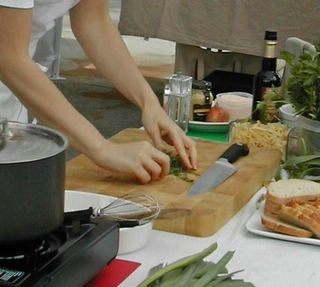Tuesday, April 26, 2005
Spices
Spices are a strange commodity with amazing history attached. To a lot of us, herbs and spices add an ethnic flair, liven up a dish or are just something sitting prettily in a jar, slowly turning to dust. Of course, back in the day, the lure of spices sparked global exploration because they were so revered and cost more than gold. Using spices is a link to our past and a fantastic way to enliven any dish.
I thought that today I would write a little about some spices (not herbs, which are green, leafy plant parts) that I use frequently. I try to buy spices in bulk (though sadly Whole Foods no longer offers a bulk spice section) so that I use everything I have before it loses flavor. Spices should be kept in airtight containers away from sunlight and replaced every 6-8 months. Seriously.
There is a picture below of all of the spices listed here. I follow left to right. The countries or regions in parenthesis indicates what cuisine is most commonly associated with it, not necessarily where it originated. So here goes. Enjoy!
Syrian Mahlab – (Mediterranean) Really a sour cherry pit. Tiny and with a mild fruity flavor. I coarsely grind and add to oatmeal, cookies or any sweet bread. Or sweet breads.
Star Anise – (Chinese) Not only beautiful, but has a sweet-spicy flavor that is just a little bit bitter. Unless it is ground, it is not edible, so the pod must be removed before eating. A key ingredient in Master Sauce and Five Spice Powder. Makes a fantastic liquor.
Lemon Grass (Thai) A key ingredient in Thai cooking. Has a flavor very similar to lemons. Fresh lemon grass has a stronger (though never really that strong) flavor, but dried works well too and is less woody (since it is ground) so it is edible, where fresh is not easily digestible.
Dried Orange Peel - (Chinese) I am a huge advocate of orange zest, and I find that in certain sauces, adding a touch of the dried minced peel along with the fresh creates another level of flavor.
Bay Leaf – (Mediterranean) Also called Laurel. Typically used as a flavoring for soups and stocks, but removed before eating. Turkish is considered less pungent than Californian Bay, and therefore preferred, because too much bay and your dish will become bitter.
Ground Ancho Chile Powder – (Americas) In recipes I frequently call for ground chile powder, which is NOT a combination of spices, but dried chiles that have been ground up. Easy to find in Latin markets, but equally easy to make. Cayenne is an example of a ground chile powder. Ancho chile powder is sweet and rich peppers with very little heat.
Allspice – (Caribbean) So called because it supposedly tastes like nutmeg, cloves and cinnamon. Typically used in baking, it is also a great addition to grilling marinades.
Dill Seed - (Northern and Eastern European) Stronger flavor than the herb, and holds up to heat better. A wonderfully suprising spice that is great with potatoes (potato salad in particular), with roast chicken or in your crab boil, in soups or as an addition to salad dressing.
Pickling Spice – (European) A spice mixture used for pickling. (I know, that was obvious) but really under used. Charlie Trotter uses it a lot as an addition to basic sauces and it changed my world. Also good to have on hand so you can pick through it when you just need one little clove or some such.
Anise Seed – (European) Smaller and less aggressive than fennel seeds, (though from the same family. The parsley family actually) anise is more than just “black licorice” it is the key ingredient in Pastis and (when ground) my secret biscotti ingredient. Just a touch goes a long way.
Black Sesame Seeds – (Asian) Tastes the same as white (so far as I can tell) but adds a visual flair.
Turmeric – (India) More of a colorant than a flavoring, though does have a bitter flavor. Recent studies have shown that people in India suffer from Alzheimer’s less than in any other region in the world. Ongoing research suggests it may be in part due to the copious amounts of tumeric used. I say, pile it on. I add a dash to everything from mashed potatoes to tofu. Why not, right?
Chile Pepper Flakes – (World Wide) Dried crushed chiles. Usually full of heat and strong in flavor. Typically used as a pizza topping and in lots of spicy Italian cuisine.
Ground Ginger – (World Wide) Vibrant and with a touch of heat. Try it in a steak spice rub or in chicken soup.
Brown Mustard Seeds – (Indian) smaller and hotter than yellow mustard seeds. Typically heated (until they pop) mustard seeds are great in salads, as an addition to sandwiches (especially roast beef. Add a pinch to your mayo), with grilled meats and with tuna tartare. Adds heat and texture.
Epazote – (Mexican) Add to all kinds of soups, stews and sauces. An essential Mexican herb, it is purported to reduce, ahem, stomach discomfort.
________________________________________________________
True Cinnamon is native to Sri Lanka
Mustard powder was invented by Mrs. Clements of Durham, England, who made a fortune selling the dry, pale-yellow mustard flour.
During the Middle Ages, many European towns assessed taxes and rents and kept their accounts in pepper, counting it out peppercorn by peppercorn.
The Spice Girls are the best selling all-female group of all time
Grinding breaks down the cell structure of spices, making them deliver flavor more quickly and blend into a dish. The finer the grind, the more rapid the release, and therefore the more rapidly the spice looses flavor.
Ninety percent of the international spice trade is in whole spices, paprika being the only spice sold ground in significant quantities.
<< Home
